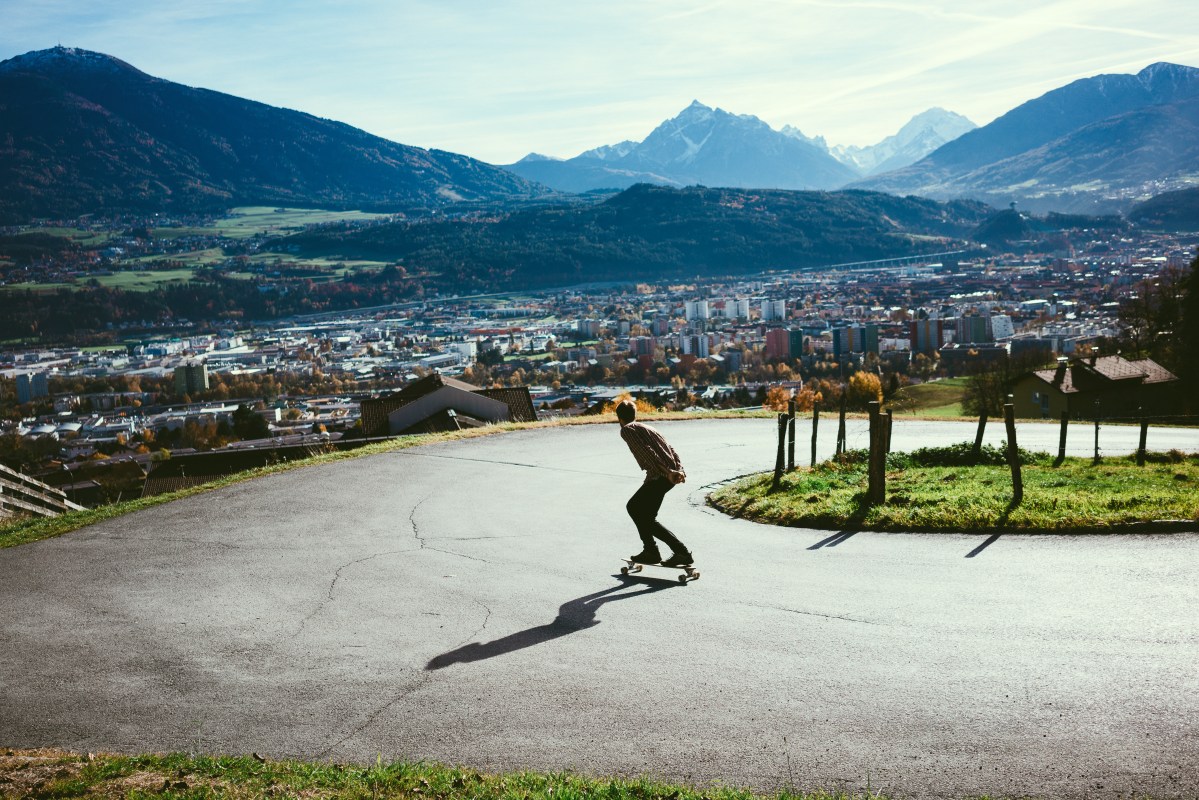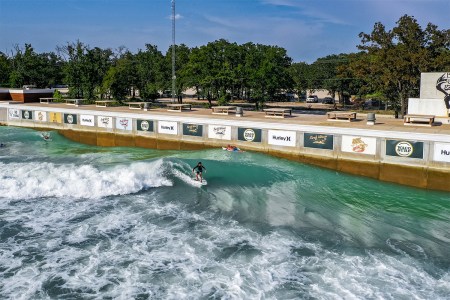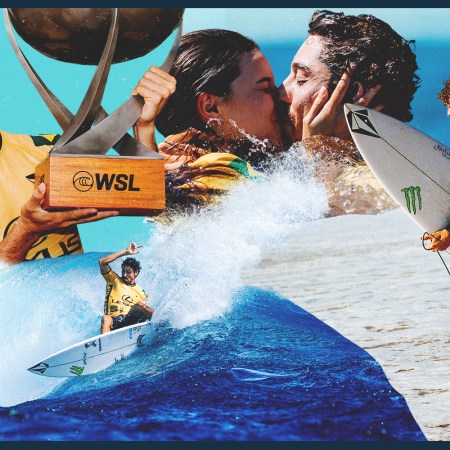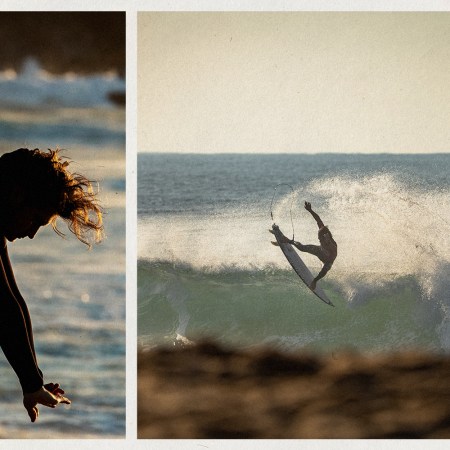Back in April 2020, at the same time that ice rinks were closed from rec youth leagues all the way up to the NHL, Alexander Ovechkin appeared in an interview with Wayne Gretsky. They were chatting about Gretsky’s all-time goals record, which the Washington Capitals’ captain still has a chance to pass one day, and at the end of the conversation, Ovechkin asked Gretsky how he would’ve stayed sharp during an indefinite quarantine. The Great One replied: “I would try to find places to Rollerblade as much as possible.”
Along with the many other bizarre “shortages” that occurred that year, Rollerblades became a hot commodity in late spring. Bauer arranged shipments for 100 of its top athletes, and across social media, NHL stars posted themselves flying around blacktops with sticks, or using them as a casual accessory to lockdown life. (Claude Giroux, for instance, got in the habit of inline skating while his baby was in his stroller.) Hockey players at the collegiate and youth levels competed with the masses for whatever inline skates they could find…and some soared to secondary prices of $1200.
Rink time — despite its reputation for overpriced hours and overstretched commutes — is a reliable constant when there isn’t a pandemic on the loose. It’s telling that so many hockey players, and especially those at higher levels, didn’t have a pair of inline skates handy when the shit hit the fan, despite the fact that as a piece of equipment, they’re a great way to fine-tune balance, strengthen single leg control and build overall power. When rinks are a given, and you don’t belong to a roller hockey league, you don’t really need a pair.
But if there’s a group of athletes that could benefit from access to gadgetry that simulates the rigors of their sport, it’s got to be surfers. The ocean can’t be “booked” the way a coach secures 90 minutes on the ice or the hardwood. You either live near waves, or wake up at dawn to drive hours back and forth to them, or carefully plan a trip across the world to chase them (you’ve likely seen a film or three on this obsession), and in every situation, it’s entirely possible to “get skunked” — you show up, and the swell just isn’t good. The waves are bad, or the weather’s wrong, and that’s that.
Surfers certainly give themselves enough chances; on average, they’re in the water 108 days out of the year. And beyond haunting their local break, over 40% of them make time for at least one international surf trip. But the stars and waves don’t always align, and even when they do, it’s likely that every other surfer in the area is aware, which makes earning priority amongst the lineup of local riders difficult. A day-long trip to the coast (or even a full weekender somewhere) could very well yield a half hour or less of actual trimming, carving or turning on waves.
For extra practice, surfers can turn to surf skateboards, also called “surfskates,” “carveboards,” or “cruisers,” which have been around since the mid-1990s, but have specifically surged in popularity over the last few years. Big-time skate manufacturers like Landyachtz now sell specific surfskates amongst their usual skateboard and longboard offerings, while a number of brands, some fledgling, some around for over a decade — Carver, Miller Division, Hamboards, , Shred MFG, Smoothstar, SwellTech SurfSkate, Zenit, etc. — all riff differently on surf skating’s core technology: an adapter that allows for total freedom of motion in the front truck.
For the Ultimate Surfing Vacation, Head to Central Texas. No, Really.
Waco Surf offers man-made waves, wakeboarding and the country’s longest lazy riverIt means that you can carve on cement, or dive-bomb downhills, or lope around the asphalt slopes of a pump track. Basically, that specialized truck allows for a similar sort of improvisation to what surfers enjoy while out on the water…only they can queue up a lengthy session with a surfskate whenever they’d like. As The Inertia pointed out in late 2021, surfskates activate an athletic “muscle memory” that’s critical for surfing, which unfortunately often atrophies due to the unpredictability of the sport.
Billy James, a longtime surfer and surfskater, and the founder of Shred Shack, credits surf skating with helping him “focus on engaging the upper body when performing turns.” He reports: “That aspect has definitely translated to my surfing. If I can’t get in the ocean, surf skating is a great way to continue the similar muscle movements.” Another surfer/surfskater I reached out to, named Curtis Ashford, says not to sleep on surf skating’s positive impacts for the lower half: “It really works the leg muscles for popping airs. You can practice your cutback and deep carves/slides.” In message boards online, lifelong surfers discuss how they’ve used boards to cut back on bogging (pesky weight displacement ticks on the board, which causes the nose to lift), or master turns of the torso, in order to generate speed. One commenter wrote: “If you want to get better and aren’t surfing 15-20hrs a week, I don’t know of a better investment.”
In other words, it works. It’s an effective form of cross-training that doesn’t veer very far from its source. But despite its penchant for making good surfers better, the unheralded pursuit’s future may rest on the pumping backs of novice surfers and even non-surfers. Some industry experts suspect that it’s taken surf skating this long to gain followers because brands have pitched their boards solely as surf trainers. But what of surf skating for the sake of surf skating? The sport has actually taken off in East Asia over the last 18 months, particularly in Thailand (which has a surf culture), and China (which does not).
In each country, quarantine angst and cultural cache (a number of high-profile celebrities started surf skating) coalesced to generate massive year-over-year growth in the surf skating sector. People wanted a new challenge, a unique adventure. Surf skating delivered. While it isn’t easy to pick up in an afternoon — it took me over a week to get a hang of my SwellTech board, and I’ve been longboarding for five years now — the movements become intuitive eventually, and the few, inevitable wipeouts fade to the rearview. Bopping around on one of these things is also flat-out fun, and once you get the hang of it you can up the crazy accordingly: take your shoes off (in many cases, this makes riding easier!), find the biggest, Walter Mitty incline in your neighborhood for minute or more of carving, or even research more out-there options, like boards that stretch over five feet, or come with SUP-style poles.
According to a recent profile by The New York Times, interest in surfing is up 17% in the United States over the last two years. So-called urban beaches, which tout cheap surf schools and “smaller, more manageable waves,” have fielded most of these newbies. For this cohort — anyone determined to accelerate their surfing talent, yet understandably unwilling to don a wetsuit in winter, or drop dollars on a trip to Byron Bay — surf skating could be a wise side quest. But the practice has its limitations. Keep in mind that a typical surfing outing demands nonstop paddling (the average paddling to wave-riding ratio is abysmal; purists love it all the same), requires strong swimming skills, asks for at least some natural knowledge of breaks and swells, and for many surfers, ultimately involves a sort of cosmic communion with the ocean, which a flexible front truck and an empty parking lot simply isn’t going to capture.
So, if you want to become a surfer, you should surf. But let’s surf skate, too. Why not? We live in a world where fitness has gotten too competitive and facilities are liable to shutter at the drop of a hat. There’s something beautiful and easy about being able to take a board down a hill whenever you like. It might make you a little better on the waves (and the snowboard slopes, for that matter) along the way, but at the very least, I promise you, it will make you happy.
The Charge will help you move better, think clearer and stay in the game longer. Subscribe to our wellness newsletter today.


























